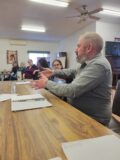Commentary
Names, faces and numbers
June 2, 2021
By Nate Smelle
In keeping an eye on the impact of the COVID-19 pandemic, we have all come to appreciate numbers in a different way over the past year. Every day on social media, we receive updates regarding the death toll, case counts, hospitalizations, outbreaks, ventilators and Intensive Care Unit beds in use, etc.
To keep us in the loop and provide us with a relatively accurate account of where we fit into the big picture of this ongoing crisis, these statistics are being delivered to us by all levels of government, and public health agencies from across Canada and around the world. Through interpreting this daily dose of numbers and figuring out how they impact our lives and livelihoods, we have developed a broader understanding of the significance of numbers and what they represent. In the case of COVID-19, as it has been with every global pandemic in human history, we have learned that there is a human face and name associated with every statistic.
With 1.38-million cases and 25,561 deaths from COVID-19 nation-wide; and, 171-million+ cases and 3.55-million deaths globally, everyone of us now has a personal connection with someone represented by these numbers. Moving beyond the pandemic, hopefully this lesson will translate into empathy for others, and meaningful action being taken to address the crises we face as a species. By means of this shared experience, whether talking about the number of people killed by the opioid epidemic, poverty, contaminated water, or the climate crisis, we can no longer disassociate the names and faces disguised by our numbers.
Over the weekend, Canadians were given another number to interpret – 215. This number tells a horrific story of systemic abuse and torture that we previously endorsed in our pursuit of a twisted notion of “progress.” Through our silence and complacency, we have allowed the inherently racist agenda of colonization to rot away the integrity of nearly everything that makes us proud to be Canadians.
We must never forget that every one of the 215 dead Indigenous children found in the mass grave at the now-closed Kamloops Indian Residential School in British Columbia had a name and a face. We must also remember that everyone of these children had parents, grandparents, Elders, friends, and a community from which they were stolen.
Make no mistake, Canada’s residential school system was not a tragic accident, originally created with good intentions. It was a carefully calculated and malevolent attempt to destroy the rich diversity of Indigenous cultures that have existed here on Turtle Island since time immemorial.
One of the main architects of the residential school system and Canada’s first prime minister, John A. MacDonald actively promoted the separation of Indigenous children from their families and communities. In 1883, MacDonald declared, “When the school is on the reserve the child lives with its parents, who are savages; he is surrounded by savages. Indian children should be withdrawn as much as possible from the parental influence.”
Without a doubt, the residential school system was our government’s attempt to dehumanize and destroy the First Peoples who inhabited this land when they arrived. Now it serves as a reminder of the cultural genocide that gave rise to the nation we now call Canada.
Before we can hold our heads high as Canadians, we need to understand and address this hard truth, so that we can actually begin the process of reconciliation. If however we choose to continue looking the other way, the 215 Indigenous children killed in Kamloops, and the countless others forgotten in the soil outside Canada’s other 138 residential schools, will be remembered only as a number.


















